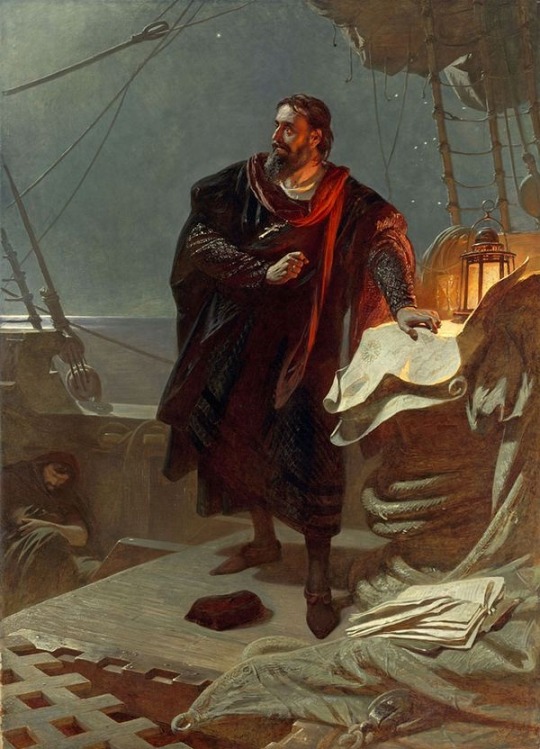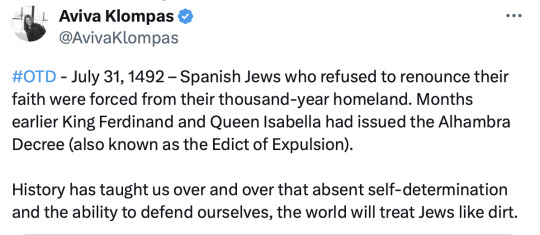#1492
Explore tagged Tumblr posts
Text
And we wouldn’t have to pay to see ourselves in museums.
Source
#indigenous#native#land back#first nations#native people#native american#mesoamerica#indigena#native america#turtle island#ndn tumblr#1492#ndn#n8v#ndn tag#decolonize#videos
978 notes
·
View notes
Text

2K notes
·
View notes
Text

Columbus in the New World by Edwin Austin Abbey
#edwin austin abbey#art#christopher columbus#new world#america#american#caribbean#explorer#discovery#age of sail#age of discovery#age of exploration#armour#europe#european#americas#christianity#christian#conquistadors#conquistador#spanish#spain#flamingo#flamingos#heraldry#history#1492#banners#conquistadores#explorers
58 notes
·
View notes
Photo

A map illustrating Christopher Columbus’s image of the world before his first voyage in 1492. It was based on a map by the Italian scholar Paolo dal Pozzo Toscanelli, which depicted the Earth as about 25% smaller than it actually is, exaggerated the reach of Asia to the east, and ignored the (correct) measurements of Eratosthenes from some 1700 years earlier. Columbus compounded these errors with...
36 notes
·
View notes
Text

#movies#polls#1492: conquest of paradise#1492 conquest of paradise#1492#conquest of paradise#90s movies#ridley scott#gérard depardieu#armand assante#sigourney weaver#loren dean#Ángela molina#requested#have you seen this movie poll
31 notes
·
View notes
Text
🇪🇸 Ladino es un idioma romance hablado principalmente por judíos sefardíes en Israel, los Balcanes, el norte de África, Grecia y Turquía, aunque está casi extinto en muchas de estas regiones. Este idioma tiene sus raíces en España y fue llevado a sus ubicaciones actuales por los descendientes de los judíos españoles que fueron expulsados después de 1492. Ladino conserva muchas palabras y características gramaticales que han desaparecido del español moderno. También tiene un sistema de sonidos más conservador; por ejemplo, mantiene los sonidos "f" y "g" donde el español moderno usa una "h" muda, como se puede ver en "fijo" y "fablar" del ladino en comparación con "hijo" y "hablar" en español, o en "agora" del ladino versus "ahora" en español. Históricamente, el ladino se escribía con escrituras hebreas como Rashi o Solitreo, pero en el siglo XXI es más comúnmente escrito con el alfabeto latino. Además, el ladino tiene una tradición literaria de siglos, incluyendo muchas obras traducidas.
🇮🇱 El ladino es una lingua romance ke es hablada prinsipialmente por djidios sefarditas en Israel, los Balcanes, el Norte de Afrika, Grecia i Turkiya, anke es pratikamente istinta en munchas de estas rejiones. Esta lingua tiene sus rases en Espanya i fue traída a sus lokalidades aktuales por los descendientes de los djidios espanyoles ke fueron eschados despues de 1492. El ladino guarda munchas de las palavras i karacteristikaz gramatikales ke disparecieron del espanyol moderno. Tambe tiene un sistema de sonios mas konservador; por eshemplo, mantiene los sonios "f" i "g" onde el espanyol moderno usa una "h" ke no se pronunsia, komo se ve en "fijo" i "fablar" del ladino kontra "hijo" i "hablar" en espanyol, o en "agora" del ladino kontra "ahora" en espanyol. Istorikamente, el ladino se eskrevia kon skripturas ebreas komo Rashi o Solitreo, pero en el siglo XXI es mas komunmente eskrito kon el alfabeto latino. Ademas, el ladino tiene una tradision literaria de siglos, inkluyendo munchas obras traduzidas.
🇺🇸 Ladino is a Romance language spoken by Sephardic Jews primarily in Israel, the Balkans, North Africa, Greece, and Turkey, though it is nearly extinct in many of these regions. This language has its roots in Spain and was carried to its current locations by the descendants of Spanish Jews who were expelled after 1492. Ladino retains many words and grammatical features that have disappeared from modern Spanish. It also has a more conservative sound system; for example, it maintains "f" and "g" sounds where modern Spanish uses a silent "h," as seen in Ladino's "fijo" and "fablar" versus Spanish's "hijo" and "hablar," or in Ladino's "agora" versus Spanish's "ahora." Historically, Ladino was written using Hebrew scripts like Rashi or Solitreo, but in the 21st century, it is more commonly written in the Latin alphabet. Additionally, Ladino has a centuries-old literary tradition, including many works in translation.
Britannica, The Editors of Encyclopaedia. "Ladino language". Encyclopedia Britannica, 14 Dec. 2023, https://www.britannica.com/topic/Ladino-language. Accessed 3 May 2024.
#espa��ol#ladino#judeoespañol#sepharad#sephardic#jumblr#jewish#judaísmo#herencia judía#identidad#identidad cultural#cultura judía#cultura sefardí#lenguas romances#sefardí#sephardi#sephardi jewish#historia judía#judaism#israel#grecia#turquía#españa#spain#jewish culture#1492#expulsión#judíos sefarditas#sefarditas
37 notes
·
View notes
Text

The Sword and the Cross of Colonization in the Americas
By Alejandra Garcia
Every October 12, the peoples of the Americas remember the first arrival of Christopher Columbus to the New World, in 1942, as a date that marks a milestone in the history of genocide, plunder and exploitation. Far from being a day of celebration, it is a day of struggle, of resistance to oblivion.
It is impossible to deny the transcendence of what happened in 1492: the arrival of the values and appetites of the nascent capitalist society, the beginning of the globalization of the world and the conversion of human history into one single history, and even the division of the world as we know it today.
#Columbus Day#Indigenous Peoples Day#genocide#colonialism#capitalism#1492#imperialism#slavery#revolution#indigenous#latin america#Cuba#Struggle La Lucha
14 notes
·
View notes
Text

50 notes
·
View notes
Photo

America: Being the Latest, and Most Accurate Description of the New World (1671)
#america#north america#south america#central america#west indies#the new world#1492#aztec empire#inca empire#american indians
87 notes
·
View notes
Text

💔
#stop police brutality#police brutality#imperial force#imperialists#imperialism#tyranny#racism#genocide#georgefloyd#sandrabland#black panther party for self defense#civil rights movement#1619#1492#police the police#free the political prisoners#black family#melanin#marcus garvey#prisoners of war#replace white supremacy with justice#africa#caribbean#cuba#black people#police brutality 2024#military occupation#eugenics#ethnic cleansing#humanity
3 notes
·
View notes
Text
Christopher Columbus and Playing Cards

Chatto, W. Andrew., Levis, H. Coppuck., Thordarson Collection., Lessing J. Rosenwald Reference Collection (Library of Congress)., Harry Houdini Collection (Library of Congress). (1848). Facts and speculations on the origin and history of playing cards. London: J. R. Smith.
2 notes
·
View notes
Text

Christopher Columbus by Carl von Piloty
#christopher columbus#art#carl von piloty#explorer#explorers#exploration#discovery#new world#america#americas#europe#european#christianity#spain#spanish#1492#history#conquest#ship#map#maps#caribbean#lamp#christian#voyage#niña#pinta#santa maria#atlantic ocean#voyages
106 notes
·
View notes
Photo

The Iberian Conquest of the Americas
European explorers began to probe the Western Hemisphere in the early 1500s, and they found to their utter amazement not only a huge landmass but also a world filled with several diverse and populous indigenous cultures. Among their most important conquests were those of Christopher Columbus in the Caribbean (1492-1502); Hernán Cortés in Aztec Mexico (1519-1521), Francisco Pizzaro and Diego de Almagro in Inca Peru (1528-1532), and Juan de Grijalva (1518) and Hernán Cortés (1519; 1524-1525) in Mayan Yucatán and Guatemala.
Indigenous Peoples of the Americas
The Aztec civilization was located in the Gulf Coast Plains of central America and the high reaches of the Sierras. Their empire was a confederation of three huge city-states established in 1427: Tenochtitlan, the capital located on an island near the western shore of Lake Texcoco in central Mexico, Texcoco in the central Mexican plateau, and Tlacopan in the Valley of Mexico on the western shore of Lake Texcoco.
The Incas were found in the Andes and coastal regions of South America. Their empire arose in the early 13th century and was the largest kingdom in pre-Columbian America, with its capital at Cuzco, in modern-day Peru. The Inca civilization controlled a large portion of western South America through conquest and the collection of tributes from client states.
The Maya civilization had once ranged across southeastern Mexico, all of Guatemala and Belize, and the western portions of Honduras and El Salvador. When the Spanish arrived, the Maya civilization was well past its golden age (250-900 CE) but still had a significant presence in the Yucatan Peninsula and the highlands of Guatemala.
The Taínos and Caribs were widely distributed across the Greater and Lesser Antilles in the Caribbean Sea. These societies did not have a centralized government but were ruled by a myriad of regional hereditary chiefs and noble classes. At the time of Columbus' arrival in 1492, there were five chiefdoms of the Taíno civilization in Hispaniola, each led by a principal cacique (chief) to whom tribute was paid.
The Tupi-Guarani inhabited the Amazon rainforest and most of Brazil's coast. Like the Taíno, the Tupi-Guarani had no central government but were divided into thousands of tribes, each numbering from 300 to 2,000 people. In 1500, the Tupi numbered about 1 million people, nearly equal to the population of Portugal.
Continue reading...
25 notes
·
View notes
Text
As far as we know, the first testimony of a change in climate in America comes from Gonzalo Fernández de Oviedo, military governor in Santo Domingo and royal chronicler of the Indies. When he was writing, in 1548, the improvement of the American climate was no longer a mere hope, as in Columbus, but an attested, widely shared view [...] The basis of climate improvement, according to Oviedo, was political: desiccation and cooling were due to ‘Spanish sovereignty, which tames (doma) and mellows (aplaca) these regions and their rigours, just as it tames the Indians and animals inhabiting them.’ Climate change reflected, hallowed, and sanctified the transition from one sovereignty to another. If, in the initial stages of the conquest, Hispaniola was hot and humid, this was because it had been possessed ‘for so long by savage peoples’; because ‘neither trodden nor ploughed . . . the forests grew incessantly’; and because ‘its very few paths were like rabbit tracks.’ The non-domination of nature, and a relationship to the land akin to that of animals, invalidated Indian claims to sovereignty. Oviedo envisaged his natural history as a providentialist treatise on behalf of the global reign of Charles V. Climate improvement attested to a divine plan for Spanish sovereignty over the New World.
— Jean-Baptiste Fressoz & Fabien Locher (translated by Gregory Elliott), Chaos in the Heavens: The Forgotten History of Climate Change.
Follow Diary of a Philosopher for more quotes!
#Book Quotes#Climate change#environmentalism#ecology#global warming#quote#quotes#colonisation#colonialism#imperialism#America#native american#Latin America#History quote#New World#climate crisis#climate emergency#environment#1492#gradblr#studyblr#book quote#academia#dark academia#chaotic academia#solarpunk#ecopunk#green#nature
3 notes
·
View notes

